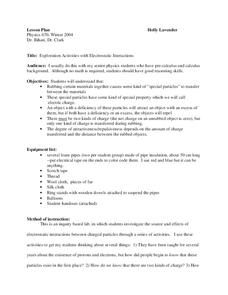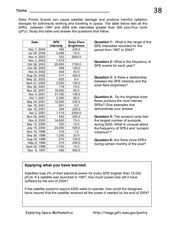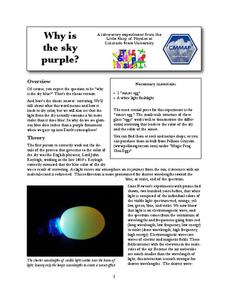Curated OER
Alternative Energy Resources
In this alternative energy resources instructional activity, learners identify the ore that is commonly used in nuclear power plants and how it is processed. Then they determine the reaction that occurs when uranium atoms are split....
DiscoverE
Working with Watermills
Water is a powerful force; harness it through watermills. The task at hand is to create a simple watermill that functions in flowing water for at least three minutes. Scholars work together in teams to design and construct such a...
Curated OER
Protective Relay Circuits
In this physics worksheet, students answer 4 short answer questions on protective relay circuits. They explain how differential relay works.
Curated OER
Micro-controller Principles
Learners research micro-controllers and complete this 20 question worksheet on micro-controller circuits using schematics. This worksheet is printable and the answers are revealed online.
Curated OER
Deducing Induction
Students examine how changing magnetic fields induce currents in
loops and coils, determine orientation and magnitude of magnetic field,
describe Michael Faraday's experiments that led to conclusion that changing
magnetic force induces...
Curated OER
Activity One -- Fundamentally Speaking
In this science worksheet, learners examine how the universe is bound with the atomic particles and focus upon the findings of two historical scientists.
Texas State Energy Conservation Office
Are Your Computers Wasting Energy?
After reading about the amount of energy that is used to power a personal computer, learners take a look at their own computer use and therefore, their energy consumption. They do this through a series of questions and computations on...
Ohio State University
Exploration Activities with Electrostatic Interactions
Step out of the 21st century and discover protons and electrons through observation. Using common materials, participants continually adjust their explanation of charges. The final assessment requires pupils to design their own...
Curated OER
The Formation of Coal
In this coal formation worksheet, students read and informational sheet about coal formation. Students are given 5 short-answer questions regarding what they've read.
Curated OER
Chalkboard Challenge: The Periodic Table and Periodicity
In a well-prepared Jeopardy-style game, your chemisty class can review the periodic table. Questions cover the element groups, some history, atomic number, atomic and ionic radii, electronegativity, and the shielding effect. What a fun...
NASA
Water Rocket Launcher
How can you launch an object that isn't propelled by air? The resource provides directions to build a launcher to launch rockets made of two-liter bottles. The launcher, built mainly from materials found at the local hardware store, uses...
Curated OER
Types of Trains
Third graders explore different types of trains. In this science lesson, 3rd graders study the "Orphan Train" and write a paragraph about what it would feel like to be riding a train during this time period.
Curated OER
Plugged in to CO2
Learners use a meter to measure the energy used and carbon produced by electronics and appliances. In this environmental science and technology lesson, students use a Kill-A-Watt meter to determine the electricity used by everyday...
Curated OER
Protecting Treasures
Students explore electricity by creating an alarm. In this circuitry instructional activity, students analyze a diagram of a circuit based alarm which detects sunlight. Students utilize electrical equipment to recreate the circuit and...
Curated OER
Will There be Enough Water?
Students investigate water usage, water available, and water demand historically in the local area. They use projections of water usage, availability and demand up to the year 2050. Students use graphs to relate as well as compare and...
Curated OER
Energy Efficiency at Home: An Interdisciplinary Module for Energy Education
Students examine energy efficiency and how they use energy at home. In this energy conservation instructional activity students complete several science activities that give students a better understanding of energy.
Curated OER
Earth Day Crossword Puzzle-- Difficult
In this science worksheet, students participate in an Earth Day activity by completing a crossword puzzle. Students read each clue. The answer which fits in the puzzle is provided in a scrambled word form. Students unscramble the words...
Curated OER
Storms and Extreme Weather
Students explore hurricanes and tornadoes by conducting an experiment. In this weather pattern lesson, students define many extreme weather vocabulary terms and discuss the relationship with static electricity. Students utilize plastic...
Curated OER
The Greenhouse Effect
Why does it get so hot inside of our cars in the summertime? The greenhouse effect! Lab groups experiment to see what happens to an ice cube enclosed in a jar and placed in sunlight as compared to an ice cube outside of the jar. They...
Chymist
Batteries
Young scientists study the construction of a battery through experimentation. They engage in five experiments which combine to create a thorough study of the history of batteries beginning with a model of the first battery.
Curated OER
Solar Proton Events
On this worksheet, space scientists use a data table to answer questions about the relationship between the brightness of solar flares and the intensity of the solar proton events. They apply what they learned from the data to address...
University of Colorado
Spacecraft Speed
Space shuttles traveled around Earth at a speed of 17,500 miles per hour, way faster than trains, planes, or automobiles travel! In the 13th installment of 22, groups graph different speeds to show how quickly spacecraft move through...
Curated OER
How Am I Supposed to Eat THAT?
Students explain nutritional strategies of benthic organisms.They describe nutritional strategies of benthic organisms and describe these physical characteristics.
Colorado State University
Why Is the Sky Purple?
The color of the sky depends on the time of day. Young scholars experiment with scattering different wavelengths of light to recreate the color of the sky. They observe both the longer blue wavelengths and the shorter red and orange...

























